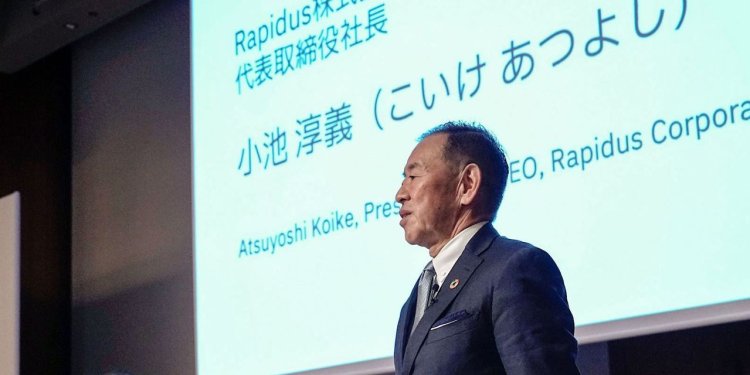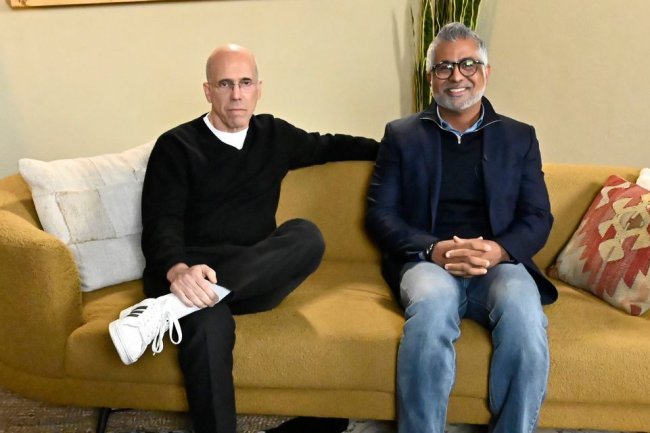Japan’s Plan to Become a Chipmaking Champ Hinges on This Startup
Startup Rapidus looks to invest $35 billion, work with U.S. to counter China’s tech ambitions Atsuyoshi Koike heads Rapidus, a company that Japan hopes will help it recover its leading role in the global semiconductor industry. Photo: Kyodonews/Zuma Press By Peter Landers and Yang Jie July 6, 2023 11:00 am ET TOKYO—In his rare off-hours, Atsuyoshi Koike, a 71-year-old Japanese engineer, likes to put on pads and play tailback in weekend football games. Koike is carrying the ball for Japan in a different contest, this one with tens of billions of investment dollars and global economic security at stake. After slipping near the bottom of the semiconductor-manufacturing league, Tokyo once again wants to field a championship con


Atsuyoshi Koike heads Rapidus, a company that Japan hopes will help it recover its leading role in the global semiconductor industry.
Photo: Kyodonews/Zuma Press
TOKYO—In his rare off-hours, Atsuyoshi Koike, a 71-year-old Japanese engineer, likes to put on pads and play tailback in weekend football games.
Koike is carrying the ball for Japan in a different contest, this one with tens of billions of investment dollars and global economic security at stake. After slipping near the bottom of the semiconductor-manufacturing league, Tokyo once again wants to field a championship contender.
Koike heads a startup called Rapidus that plans to invest some $35 billion by 2027 building a factory in northern Japan to manufacture 2-nanometer chips, the current state-of-the-art design.
When he met Commerce Secretary Gina Raimondo early this year to discuss the plan, Koike said he told Raimondo that he felt his team was going for it on fourth-and-inches, signifying a risky gamble, except this play would be “fourth and 2 nanometers.” Raimondo and the other Americans broke out laughing, he recalled in a recent interview, and she told him that the Japanese plan would get Washington’s full support.
It helps that Koike is well-versed in the kind of football beloved by Americans, because the project relies on the kind of U.S.-Japan cooperation that would have been inconceivable in Japan’s glory days of the late 1980s.
The $53 billion Chips Act seeks to end the U.S.’s reliance on foreign-made semiconductors, especially those used by the Pentagon. It’s the latest example of the federal government using its cash to remake an industry it sees as crucial to national security.
Back then, Japan accounted for about half of the global semiconductor industry, and the U.S. was left to beg, plead and threaten as it tried to get a small slice of the Japanese market. A bestselling book in Japan during the Cold War’s waning days called “The Japan That Can Say No” suggested that Tokyo could leverage its dominance in semiconductors to control the world’s military balance—and perhaps help the Soviet Union instead of the U.S.
Today, the great fear driving chip investments is China, and U.S. policy calls for helping allies such as Japan build a supply chain that is less exposed to risks posed by a hostile Beijing. China is trying to build its own world-leading semiconductor industry and is threatening to take by force if necessary the self-ruled island of Taiwan, which Beijing considers part of its territory and where the majority of the world’s most cutting-edge chips are made.
While the U.S. is expanding its own chip production through the Chips and Science Act, which includes some $53 billion of spending, people involved in the Rapidus project said the U.S. needed further global diversification.
“There is no path for us to make a real dent” in the current Taiwan concentration without investments by U.S. allies, said Darío Gil, director of research at International Business Machines. “The situation is so lopsided, it is going to be a massive coordinated effort.”
IBM, the first company to announce 2-nanometer technology in 2021, is supplying its chipmaking playbook to Rapidus, making it the central partner in Koike’s game plan.
The U.S. and Japan have already teamed up against China by limiting its access to advanced chipmaking technology, prompting Beijing to retaliate by controlling exports of two minerals used in chips. A Chinese Ministry of Commerce spokesperson said July 1 that the U.S. has “abused export control measures even at the expense of its allies’ interests” and seriously damaged the industry.

South Korea’s Samsung Electronics is a global leader in advanced chipmaking.
Photo: jeon heon-kyun/Shutterstock
From its peak more than three decades ago, Japan’s share of the global semiconductor industry has fallen to just under 10%, according to the Semiconductor Industry Association. In manufacturing, most Japanese output consists of memory chips, not the logic and graphics chips that power products such as the iPhone, videogame machines and artificial-intelligence chatbots.
Koike, the Rapidus chief executive who has worked in chipmaking at Hitachi and Western Digital, said Japanese companies in the 1990s grew arrogant and insular. “We thought we could do everything by ourselves,” he said.
Japanese companies in that era developed chips mainly for their own products. They were left stranded when the industry reorganized itself into manufacturing specialists, such as Taiwan Semiconductor Manufacturing in Taiwan, that own semiconductor fabrication plants or fabs and “fabless” companies such as Apple and
Nvidia that specialize in chip design.Japan still leads the world in niche parts of the supply chain, such as chemicals used in chipmaking. A government-backed investment fund in June offered more than $6 billion to buy one of those chemical makers, a Tokyo company called JSR.
But the country felt the lack of domestic manufacturing capacity during the pandemic-era chip shortages that battered its car industry.
Rapidus aims to get Japan back into the heart of the business by building facilities on the northern island of Hokkaido, known for its ski resorts. Rapidus says it wants to begin pilot production in 2025 and full-scale production in 2027. Some 6,000 workers are being drafted to put up the factory.
The project has drawn skepticism over its financing and ambitious timeline. Koike said he can’t spell out yet where he will get the $35 billion or so that he needs by 2027. Japanese companies including Sony Group
and Toyota Motor invested small sums to help get Rapidus going, but people involved in the project said those companies aren’t expected to put in the bulk of the money.Koike said the Japanese government, which has committed more than $2 billion so far, works on a year-by-year budget, so he said he is confident more funding will come if Rapidus hits its milestones. He said a public offering of shares could come eventually, but only when the company has products ready for the market.
Japan’s Ministry of Economy, Trade and Industry has said that it intends to help Rapidus achieve its goals, and that it wants the Japanese semiconductor industry to have revenue of some $100 billion in 2030, triple the 2020 figure.
The ministry is pitching in billions of dollars for additional projects in Japan. TSMC is building an $8.6 billion factory on the southern island of Kyushu and is in talks about a second.

Atsuyoshi Koike of Rapidus and IBM’s Darío Gil, both center, after the two companies signed a deal to develop chips last year.
Photo: Kyodonews/Zuma Press
Micron Technology in May announced a $3.6 billion investment in advanced memory chips at its Hiroshima factory.
Assuming it gets the money, Rapidus still has to master a level of manufacturing technology attained so far by only two companies, TSMC and South Korea’s Samsung Electronics. Both are projected to have the ability to mass-produce 2-nanometer chips by 2025.
SHARE YOUR THOUGHTS
What should or shouldn’t the U.S. and allies do to secure semiconductor supplies? Join the conversation below.
“It would be super challenging for Rapidus to produce 2-nanometer chips,” said Jui-Lin Yang, a consulting director at Taiwan’s Industrial Technology Research Institute, which has ties to TSMC.
Gil of IBM said the biggest challenge would be finding customers because Japan doesn’t yet have many companies demanding the most advanced chips and overseas companies are more comfortable with established suppliers.
“There’s a massive amount of work that needs to be done,” he said. Koike said Rapidus will provide customers with quick turnaround on the most advanced chips. “What takes others three months, we’ll do in a month,” he said.
—Chieko Tsuneoka contributed to this article.
Write to Peter Landers at [email protected] and Yang Jie at [email protected]
What's Your Reaction?

















